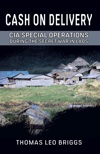 Thomas Briggs’ personal memoir, Cash on Delivery, gives a rare and valuable glimpse into American involvement in the little publicized secret war in southern Laos, Military Region III. Unlike more prolific works dealing with General Van Pao’s Hmong forces in Military Region II north of Vientiane to the Plain of Jars, covert U.S. and Lao activities around the strategic Bolovens Plateau has been largely unreported.
Thomas Briggs’ personal memoir, Cash on Delivery, gives a rare and valuable glimpse into American involvement in the little publicized secret war in southern Laos, Military Region III. Unlike more prolific works dealing with General Van Pao’s Hmong forces in Military Region II north of Vientiane to the Plain of Jars, covert U.S. and Lao activities around the strategic Bolovens Plateau has been largely unreported.
Briggs’ service, following a tour in Vietnam as a military police officer, was timely because North Vietnamese expansion of operations south and west coincided with the period of his 1970-72 tour in Laos. The loss of the use of Sihanoukville port in early 1970, when Lon Nol came to power in Cambodia, stratified the North Vietnamese Army’s (NVA) efforts to protect the western salient of the Ho Chi Minh Trail. This entailed expanding rainy season combat operations, when U.S. air power was most adversely affected by weather, toward Pakse, Paksane and the Bolovens Plateau, including Attopeu, key population centers between the Bolovens Plateau and the Trail.
CIA operations in Military Region III at the time were largely structured around Road Watch operations, a time-tested relic from the OSS and Coast Watcher days of World War II when clandestine teams or individuals watched and reported on enemy troop movements and dispositions. Prior to going in-country, Briggs and a colleague spent time attempting to analyze and put some sense into voluminous Road Watch reports languishing unread at headquarters in Langley, Va. It was apparent that the gathering of and reporting of intelligence by indigenous assets with little ability to provide meaningful descriptions—locations or likely destinations or intentions—was worthless. Complicating matters was reporting veracity, so unreliable that polygraphs were routinely used to check if the teams were fabricating their observations and reporting locations.
The Agency’s preoccupation with technical collection methods was a significant setback, and Briggs emphasized defections and capture of NVA personnel instead.
Brushes with the bureaucracy and technology notwithstanding, the author had stunning successes and innovations. One of the clearest examples of combined U.S.-Lao heroism is detailed in his account of the rescue of Raven 42, a USAF forward air controller shot down in an epic battle on the Bolovens Plateau as North Vietnamese forces tried to capture Pakse. While fellow Raven FACs juggled an unending stream of U.S. Navy and Air Force tactical air, the wounded pilot and his Lao backseat observer, who refused to abandon him, hid from the North Vietnamese who had shot them down. Briggs downplays his own role in the rescue, riding in on the rescue helicopter and administering what may have been lifesaving first aid to the downed pilot.
Briggs’ emphasis on defections and capture of NVA personnel was significant, but these operations also cite a poignant example of timely, critical intelligence that went unnoticed and failed to stop an operation of the greatest significance in neighboring Vietnam—the Easter Offensive of 1972.
Four decades later, as terrorists smuggle bombs onto airliners while a plethora of dots go unconnected, the parallels between the timely and accurate intelligence on the Easter Offensive provided by one of these defectors, a virtual playbook of North Vietnamese intentions, being ignored at Langley, is striking.
The gulf between the highest echelons at the policy level and the young field operatives is cited as a great concern. Careerism at the top and the shrinking pool of midlevel intelligence professionals to mentor these young operatives are also viewed as alarming trends.
The book is not without flaws. Redundancy and restatement of previously reported information could have been trimmed with a more thorough editing. Similarly, the author seems to have concentrated a little too solely on his own role and mission. The significant MACV-SOG Operation Tailwind that occurred in September 1970 was a key U.S. response to North Vietnamese operations affecting Vietnam, but it isn’t mentioned, in spite of its occurrence in the Bolovens area. Three decades later the operation would gain notoriety as a CNN-Time magazine news fiasco. Despite these minor shortcomings, Briggs’ book should be read, especially by the intelligence professionals dealing with the complex, multifaceted conflicts of the 21st century.
Rosebank Press, 2010




